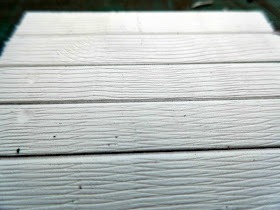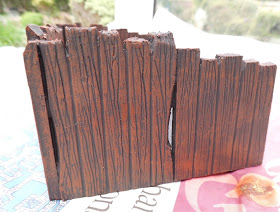 Some of the first wagons I constructed for my railway were open wagons to transport coal down the line (see How I constructed some open wagons and How I constructed some open wagons from resin castings). A common feature in station yards during the steam era would have been coal bins, sometimes called 'staithes'. In the UK they were often constructed from old wooden sleepers.
Some of the first wagons I constructed for my railway were open wagons to transport coal down the line (see How I constructed some open wagons and How I constructed some open wagons from resin castings). A common feature in station yards during the steam era would have been coal bins, sometimes called 'staithes'. In the UK they were often constructed from old wooden sleepers.My first attempt at making some coal bins has not been 100% successful, as I inadvisedly made them from balsa wood (see How I made coal bins from balsa). Despite treating them with preservative, they have disintegrated over little more than a couple of years, and so I wanted to find something which was a bit more durable. Having recently discovered PVC foamboard and constructed a couple of buildings from this versatile material, I decided it would be more than suitable for my next set of coal bins (see How I constructed the water mill and How I constructed the Brewery. These would be situated at the intermediate stations on my railway - Beeston Castle, Peckforton and Bulkeley.
The first two sets of bins were made from scraps and offcuts of 3mm and 5mm thick foamboard left over from making the brewery. I get my supplies of PVC foamboard from Simply Plastics, who supply it in pre-cut sizes such as A2, A3 and A4.
I started off by measuring and cutting a piece of 3mm thick foamboard for the base. Its size was dependent on the site it would occupy. This particular structure would be situated at Peckforton Station, where I had identified a space 220mm x 90mm.
The front edge of the base was bevelled with a craft knife to allow the finished model to be more easily bedded into to its eventual site.
I then started creating the wall sections. I decided to make the back wall 70mm tall - representing 4' 4½" in 16mm scale, which seemed about right, assuming the bins would have been made from redundant sleepers from my 3' gauge railway. These were cut from 5mm thick foamboard.
The various sections (their lengths dependent on what scraps I had available) were divided into 10mm wide vertical 'sleepers'.
A craft knife was used to cut into the divisions between the sleepers about 6mm down.
The knife was then used to cut horizontally into each sleeper end to give the impression they were of different heights.
I found that flipping the job over enabled me to make fairly clean cuts on both sides.
The divisions between the sleepers were then scored with a flat bladed screwdriver.
The surfaces were then scored with the teeth of a razor saw, to give the impression of wood grain.
Additional deeper score lines were made with the tip of a round file.
The top ends of the sleepers were then 'distressed' by hacking them about with a craft knife.
The pieces which would become the sides and central divide for the bin were shaped, with increasingly lower sleepers down to 60mm or 55mm.
These processes were repeated until I had sufficient pieces to make the bin.
The various pieces were then glued to the edges of the base with thick superglue (I use Vitalbond which can be bought in 50g bottles reasonably priced on eBay). I started with the rear section .....
..... and then the sides and the central divider.
The bins were then set aside for the glue to set........
....... before being given a brush-painted coat of red oxide primer.
Once this had dried, the whole thing was given a coat of very dark brown acrylic paint, to represent creosoted timber.
It was important to ensure the paint found its way into every nook and cranny.
Once this had dried, the woodwork was dry-brushed with a mid-brown colour.
Once this had dried a silver-grey colour was very lightly dry-brushed over the previous coat.
The brown highlights the larger grain effect while the grey highlights the finer grain (well that's the theory!).
Dry-brushing
A broad brush is lightly dipped into the paint which is then mostly removed on a paper towel. The residue clinging to the brush is then very lightly wiped over the surface of the timber so the paint is transferred only to the upper surfaces.
A broad brush is lightly dipped into the paint which is then mostly removed on a paper towel. The residue clinging to the brush is then very lightly wiped over the surface of the timber so the paint is transferred only to the upper surfaces.
Off-cuts and chunks of foamboard were glued into the corners of the bins .......
...... and then painted black ........
........ before being coated in exterior PVA and sprinkled with crushed coal.
The bins need to be properly bedded into the surfaces of the yards at the stations and a few other details added, such as coal sacks, scales, shovels and maybe a workman shovelling.
Hopefully, these bins will be a lot more durable than their balsa predecessor. I will leave them outside over the summer but probably bring them in during the winter months to prevent moss growing on top of the coal. However, they do seem look OK and ought to be weather-resistant.



























Well Rik, that's another brilliant Blog on your build of the Coal Staithes. It's brilliantly explained and photographed in great detail.
ReplyDeleteTHANK YOU..
Thanks Rod
ReplyDeleteI hope the info is useful and interesting.
Sorry about the delay in responding. I hadn't realised there was a backlog of comments awaiting moderation.
Rik
Wow. I am addicted to your site right now. I'm going through all of your builds. Great work. I am going to borrow some of your Technics . They are great ideas. Thanks for sharing all of this great info..
ReplyDeleteHi Jhill
ReplyDeleteI'm pleased you are finding my blog interesting. I'm not trying to suggest I know all the answers, far from it, but hopefully there are one or two ideas you might find useful, particularly if you are starting out into this fascinating hobby.
Rik